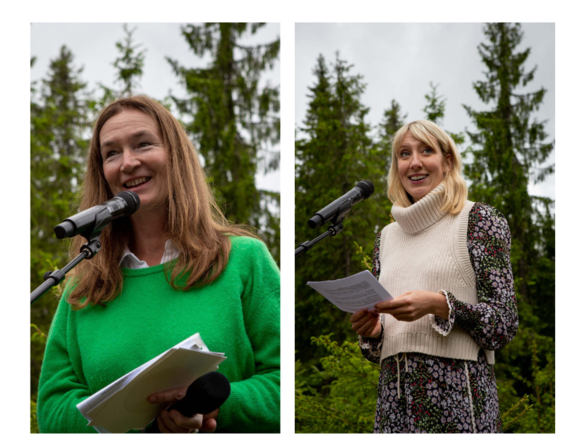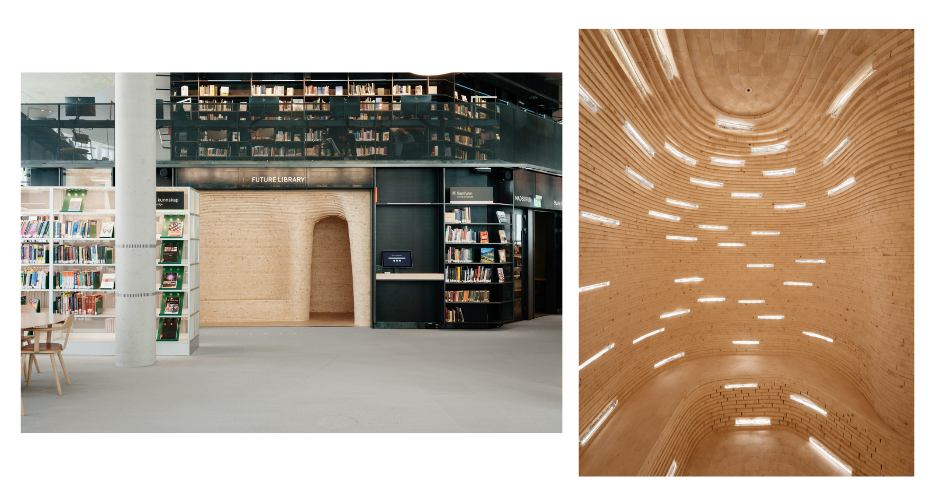
Anne Beate Hovind i Katie Paterson. Foto: Kristin von Hirsch.
Imagine an open library, one you can wander into on a stroll, but without books to read and borrow. Moreover, it's growing as you read this text!
The Future Library is an intriguing project initiated by Anne Beate Hovind, known for her work in ordering artworks in public spaces of Oslo, in collaboration with the Scottish artist Katie Paterson. In 2014, the artist planted 1000 trees that will eventually become books in 90 years. Each year, one writer is invited to craft a text that will be printed on paper made from the planted trees. These manuscripts will remain unread until the year 2114, and even the artist herself will not open them.
I wanted to learn more about the project and took the opportunity to ask Anne Beate and Katie a few questions while they were preparing to select a book for the next year. Given that ten years have passed since the project began, I asked Katie if she could briefly reflect on how the seed of the idea was initially planted.
"I'm an artist who likes daydreaming. Imagination is probably one of the most important things to me. So I was daydreaming. I was imagining tree rings. I was drawing tree rings and imagining trees as containing books and the chapters being like the tree rings and the growth of each tree kind of holding within it a book, a story. And with that, I saw a whole forest and had a very, very clear vision of this forest that was kind of like a library, growing a library for the future. And within each of these trees, they held these chapters and it was growing over 100 years. It was growing for a time frame that's just beyond human life. So it began as just a few thoughts, a few words, quite an expansive vision, but I had no idea that it could one day come to life."
Katie exhibits worldwide and delves into the concepts of land art, including time, duration, space, and experience. In collaboration with scientists and researchers globally, her projects explore our place on Earth in the context of geological time and changes: she has broadcasted live the sounds of glacier melting, mapped dead stars, and created a light bulb that simulates the experience of moonlight, among many others. To this list, she added a century-long artistic endeavor.
I was also curious why Norway was chosen as the perfect place for this project: "Well, I think Norway came to me really. I was invited to a very special kind of concept or get-together where artists were proposing artworks related to slow space and slow time. So I was invited to propose an idea and that's when I thought, Norway could really be the perfect place. It's a country of forests, of foresters, of libraries and librarians and authors, and stories and mythologies and so on. And they have an approach to long-term thinking that seemed key to the work. So Norway kind of chose the project really", says Katie.

She noted how Anne Beate Hovind was indeed the driving force behind this idea and believed that it could be realized precisely in Norway, which over the years has proven to be an excellent idea. What motivated Anne Beate to choose this project and get involved?
"I represented the commissioner and invited Katie to propose a project for the public spaces in the development of the Oslo harbor. She was given a very open brief, and I was prepared for it to be something out of the ordinary. However, I was very surprised and wasn't sure how to make this happen in the way she described it at first. It was out of time and place. Now the work has been around for 10 years and is still growing in the sense that it is relevant to our time."
It all started with Margaret Atwood, who submitted a manuscript titled Scribbler Moon, followed by David Mitchell, Sjón, Elif Shafak, Han Kang, Karl Ove Knausgård, Ocean Vuong, Tsitsi Dangarembga, and Judith Schalansky with their respective titles.
"The paramount objective of the Future Library Trust is to compassionately sustain the artwork for its 100 years duration and guiding the selection of authors. It is the board of the foundation that explores authorship, discusses, and selects the author of the year. In fact, we are meeting this week to make choices to make next year's selection. On the board, we have me the artist Katie Paterson, Publishing Director of Hamish Hamilton Simon Prosser, Director of Louisiana Museum of Modern Art Poul Erik Tøjner, Director of the Deichmanske Bibliotek Merete Lie, Publishing Director of Forlaget Press Håkon Harket and Publishing Director of Oktober Press Ingeri Engelstad.
There are really two criteria for the selection of the authors: imagination and time. Authors are free to choose the format they prefer and also the language. It can be poems, short stories, fiction, and non-fiction. I know that several of the authors have written in their native languages", says Anne Beate.
She adds that the authors have no particular preoccupations or worries when taking on this unique task: "I haven't heard that many of them fear anything. On the contrary, several have said that they think it's great to be free of critics when their text is published in 90 years. But this will change drastically for the authors who come to the end. They will be alive and face the critics in 2114. That experience will be completely different. It will be exciting to hear what they say. That is, I won't get to experience it, but my descendants will."

The new book in this library will be unveiled on Sunday, May 26th, when Valeria Luiselli will submit her manuscript during a special ceremony in the forest where people gladly participate and everyone is welcome.
"The annual handover ceremony is a highlight. We meet early in the morning and walk together into the forest and to the small Future Library clearing with the planted trees. The walk takes just 30 minutes and it's special to know that we are now following in the footsteps of nine authors before this year's. In the forest, we get coffee from the forest managers and sit down in a natural amphitheater. There we perform a ceremony similar to previous years. Simple, grounded, beautiful, and emotional. The forest manager says a few words, I say a few words, the mayor says a few words, there are cultural and natural elements and the author shares the title with us. The whole thing takes an hour and we end with a minute of listening to nature."
Behind the project lies dedication and care, and they also contemplate the publishing process. Anne Beate says that Katie plans to design the book, and future trustees will have to make all other decisions, whoever they may be in the year 2114: "We have to trust them to take on the job and execute it in the spirit of the work."
Even though ten years may seem relatively short, Anne Beate reflected on the changes she has observed in the conversation about literature and the publishing industry during this time: "For the first two years, journalists asked us if there will be books in 100 years. No one asks that anymore. Now we know that books will not be completely replaced by books. At least, we insist that this is the case. Now all journalists are preoccupied with the hopefulness of the work as it plans 90 more years into the future."

The current manuscripts are stored in the Silent Room of the new Deichman Library in Oslo. Visitors are welcome to enter the library, take a seat, and spend time in this intimate space surrounded by locked drawers containing unread manuscripts, each bearing the name of its respective writer. The room is constructed from trees sourced from the same forest that will eventually produce the books, making it a place envisioned for contemplation.
All those manuscripts created in the present moment are part of the future, and Anne Beate is precisely on that track as she envisions the future of books and libraries: "The fantastic public library of Oslo Deichman Bjørvika is hosting the beautiful Dilent Room, where the texts will remain until 2114. That's my dream. It's a fantastic meeting place, free and for everyone. Everyone in Oslo uses it regardless of background, gender, and age. Libraries and knowledge should keep us curious, facilitate the exchange of opinions, and build bridges, insight, and understanding. Books exercise our empathy muscle. We will need them in the future, just as we do today."
The project also demonstrates an extraordinary trust in the future and future generations, placing a strong emphasis on community. Who knows if it will even remain, and in what condition it will be found in 2114, considering climate change, and the uncertainty of other global events... The trust placed in the materiality and physicality of the book, rather than relying on digital formats, is truly touching in this case: "I hope Future Library continues to be relevant to young people. I hope this work gives them motivation and hope for the future. The work depends on young people taking over from us and finishing the work. On the way there, I hope they will understand the value of thinking and acting in a long-term and intergenerational way. That they take care of nature and diversity. And for my grandchildren and great-grandchildren, I hope they are proud of what I helped to start in 2014", says Anne Beate.
At the end of our conversation, we took a moment to reflect on a century ago. Anne Beate had the opportunity to choose several books that have been published in the last 100 years that readers should not miss. Besides authors and their books in this project, she says: "It's an impossible question to answer. This project has made me very aware that we know only a few of the authors that exist. And there are many books that deserve to be read as they continue to be relevant. I myself discovered the poems of Emily Dickinson and Edith Södergran when I was young. I would certainly recommend them."
*
Photographs of the ceremony were taken by Kristin von Hirsch, and the Library of the Future was captured by Einar Aslaksen.